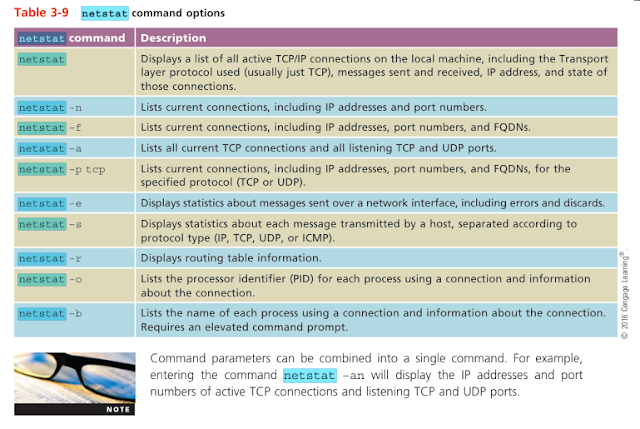netstat,
Troubleshooting Tools
You’ve already learned about four very important TCP/IP utilities—ping, ipconfig, ifconfig,
and nslookup. The following sections present additional TCP/IP commands that can help
you discover information about your node and network.
netstat The netstat utility displays TCP/IP statistics and details about TCP/IP components
and connections on a host. Information that can be obtained from the netstat command
includes the port on which a particular TCP/IP service is running, regardless of whether a
remote node is logged on to a host; which network connections are currently established for a
client; how many messages have been handled by a network interface since it was activated;
and how many data errors have occurred on a particular network interface. As you can imag-
ine, with so much information available, the netstat utility makes a powerful diagnostic tool.
For example, suppose you are a network administrator in charge of maintaining file, print, and
Web servers for an organization. You discover that your Web server, which has multiple pro-
cessors, sufficient hard disk space, and multiple NICs, is suddenly taking twice as long to
respond to HTTP requests. Of course, you would want to check the server’s memory resources
as well as its Web server software to determine that nothing is wrong with either of those. In
addition, you can use the netstat utility to determine the characteristics of the traffic going
into and out of each NIC. You may discover that one network card is consistently handling
80 percent of the traffic, even though you had configured the server to share traffic equally
between the two. This fact may lead you to run hardware diagnostics on the NIC, and perhaps
discover that its onboard processor has failed, making it much slower than the other NIC. The
netstat command provides a quick way to view traffic statistics, without having to run a
more complex traffic analysis program, such as Wireshark.
Like other TCP/IP commands, netstat can be used with a number of different parameters.
Table 3-9 shows some of these options.
CompTIA Network+ Guide to Networks, Seventh Edition
Jill West, Tamara Dean, Jean Andrews
You’ve already learned about four very important TCP/IP utilities—ping, ipconfig, ifconfig,
and nslookup. The following sections present additional TCP/IP commands that can help
you discover information about your node and network.
netstat The netstat utility displays TCP/IP statistics and details about TCP/IP components
and connections on a host. Information that can be obtained from the netstat command
includes the port on which a particular TCP/IP service is running, regardless of whether a
remote node is logged on to a host; which network connections are currently established for a
client; how many messages have been handled by a network interface since it was activated;
and how many data errors have occurred on a particular network interface. As you can imag-
ine, with so much information available, the netstat utility makes a powerful diagnostic tool.
For example, suppose you are a network administrator in charge of maintaining file, print, and
Web servers for an organization. You discover that your Web server, which has multiple pro-
cessors, sufficient hard disk space, and multiple NICs, is suddenly taking twice as long to
respond to HTTP requests. Of course, you would want to check the server’s memory resources
as well as its Web server software to determine that nothing is wrong with either of those. In
addition, you can use the netstat utility to determine the characteristics of the traffic going
into and out of each NIC. You may discover that one network card is consistently handling
80 percent of the traffic, even though you had configured the server to share traffic equally
between the two. This fact may lead you to run hardware diagnostics on the NIC, and perhaps
discover that its onboard processor has failed, making it much slower than the other NIC. The
netstat command provides a quick way to view traffic statistics, without having to run a
more complex traffic analysis program, such as Wireshark.
Like other TCP/IP commands, netstat can be used with a number of different parameters.
Table 3-9 shows some of these options.
CompTIA Network+ Guide to Networks, Seventh Edition
Jill West, Tamara Dean, Jean Andrews


